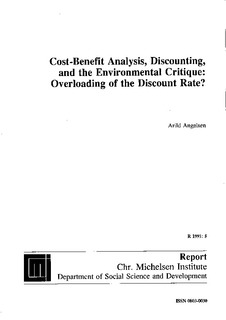| dc.contributor.author | Angelsen, Arild | |
| dc.date.accessioned | 2008-03-13T13:33:44Z | |
| dc.date.accessioned | 2017-03-29T09:12:12Z | |
| dc.date.available | 2008-03-13T13:33:44Z | |
| dc.date.available | 2017-03-29T09:12:12Z | |
| dc.date.issued | 1991 | |
| dc.identifier.issn | 0803-0030 | |
| dc.identifier.uri | http://hdl.handle.net/11250/2435770 | |
| dc.description.abstract | The use of (high) discount rates in cost-benefit analysis is being criticized in the environmental debate. In particular, some feel that high future environmental costs do not get a fair hearing in a project appraisal due to the use of high discount rates. This paper explores first the relationship between the discount rate and environmental degradation. The link is ambiguous, though the overall effect of a lower discount rate may be more environmental friendly policies. Secondly, we discuss factors which should determine the discount rate according to economic theory, and to what extent environmental considerations can be brought into this framework. Finally, the paper briefly reviews other ways of bringing environmental considerations in the analysis, e.g. taking risk, uncertainty and irreversibility into account and including sustainability constraints. The conclusion is that the present tendency of overloading the discount rate should be avoided. | |
| dc.language.iso | eng | |
| dc.publisher | Chr. Michelsen Institute. Department of Social Science and Development | |
| dc.relation.ispartofseries | Report | |
| dc.relation.ispartofseries | R 1991: 5 | |
| dc.subject | Cost-benefit analysis | |
| dc.subject | Discount rate | |
| dc.subject | Environment | |
| dc.subject | Economic theory | |
| dc.title | Cost-Benefit Analysis, Discounting, and the Environmental Critique: Overloading of the Discount Rate? | |
| dc.type | Research report | |
